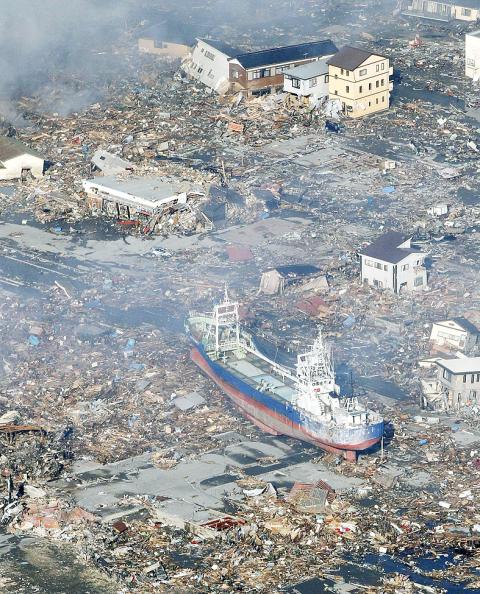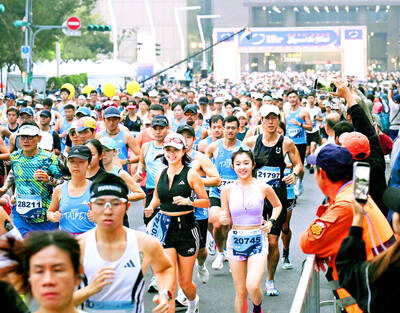An explosion and feared meltdown at a Japanese nuclear plant yesterday exposed the scale of the disaster facing the country after a massive quake and tsunami left more than 1,000 dead.
Japanese Prime Minister Naoto Kan said the magnitude 8.9 quake and the terrifying tsunami that followed were an “unprecedented national disaster” and vowed to protect those living near the stricken plant.
Reactor cooling systems failed at two nuclear facilities after Friday’s record earthquake, which unleashed a terrifying 10m tsunami that tore through coastal towns and cities, destroying everything in its path.

Photo: Reuters
Smoke was seen billowing from the Fukushima No. 1 atomic plant about 250km northeast of Tokyo after an explosion at the site.
Kyodo News agency said radioactive caesium had been detected near the aging facility, citing the nuclear safety agency.
However, Kan’s top spokesman, Yukio Edano, said that the Fukushima plant’s operator had reported the reactor container was not damaged and that radiation levels near it had fallen after the blast.

Photo: Reuters
Kyodo and Jiji reported before the explosion that the plant “may be experiencing nuclear meltdown,” while public broadcaster NHK quoted the safety agency as saying metal tubes that contain uranium fuel may have melted.
The cooling system of the plant was damaged in the massive earthquake that struck the region 24 hours earlier, leaving authorities scrambling to fix the problem and evacuate tens of thousands of people within a 20km radius.
Thousands were evacuated near another damaged plant, Fukushima No. 2.
The atomic emergency came as the country struggled to assess the full extent of the devastation wreaked by the massive tsunami, which was unleashed by the strongest quake ever recorded in Japan.
The wall of water pulverized towns and cities along the northeastern coast. Police reportedly said 200 to 300 bodies had been found in the city of Sendai.
About 300 to 400 bodies were recovered in Rikuzentakata, a coastal town of about 23,000 people, NHK quoted the military as saying.
The Fire and Disaster Management Agency said the tsunami had obliterated the town.
It was not immediately clear whether any of the bodies found by the military were included in police tolls showing at least 700 people dead. The government spokesman said at least 1,000 people were believed to have lost their lives.
More than 215,000 people were huddled in emergency shelters, police said.
The full scale of those left homeless was believed to be much higher, with police saying they had not received a tally from Miyagi Prefecture, the hard-hit region that is home to Sendai.
NHK reported that about 10,000 people are unaccounted for in the Japanese port town of Minamisanriku in Miyagi. The figure is more than half of the town’s population of about 17,000, it said.
Local authorities are trying to find their whereabouts with the help of Japan’s Self-Defense Forces, NHK said.
The raging tsunami picked up shipping containers, cars and the debris of shattered homes. It crashed through the streets of Sendai and across open fields, forming a mud slick that covered vast tracts of land.
“There are so many people who lost their lives,” an elderly man told TV reporters before breaking down in tears. “I have no words to say.”
Authorities said more than 3,000 homes were destroyed or swept away.
About 50,000 military and other rescue personnel were spearheading a Herculean rescue and recovery effort with hundreds of ships, aircraft and vehicles headed to the Pacific coast area.
Army helicopters airlifted people off the roof of an elementary school in Watari, Miyagi Prefecture.
In quake-hit areas, 5.6 million households had no power yesterday and more than 1 million households were without water. Telecommunications networks were also hit.
The quake, which hit at 2:46pm and lasted about two minutes, rattled buildings in greater Tokyo, the world’s largest urban area and home to about 30 million people.
More than 24 hours after the first, massive quake struck about 400km northeast of Tokyo, aftershocks were still rattling the region, including a strong magnitude 6.8 tremor yesterday.
The US Geological Survey said more than 100 aftershocks had hit the area.

A car bomb killed a senior Russian general in southern Moscow yesterday morning, the latest high-profile army figure to be blown up in a blast that came just hours after Russian and Ukrainian delegates held separate talks in Miami on a plan to end the war. Kyiv has not commented on the incident, but Russian investigators said they were probing whether the blast was “linked” to “Ukrainian special forces.” The attack was similar to other assassinations of generals and pro-war figures that have either been claimed, or are widely believed to have been orchestrated, by Ukraine. Russian Lieutenant General Fanil Sarvarov, 56, head

SAFETY FIRST: Double the number of police were deployed at the Taipei Marathon, while other cities released plans to bolster public event safety Authorities across Taiwan have stepped up security measures ahead of Christmas and New Year events, following a knife and smoke bomb attack in Taipei on Friday that left four people dead and 11 injured. In a bid to prevent potential copycat incidents, police deployments have been expanded for large gatherings, transport hubs, and other crowded public spaces, according to official statements from police and city authorities. Taipei Mayor Chiang Wan-an (蔣萬安) said the city has “comprehensively raised security readiness” in crowded areas, increased police deployments with armed officers, and intensified patrols during weekends and nighttime hours. For large-scale events, security checkpoints and explosives

PUBLIC SAFETY: The premier said that security would be tightened in transport hubs, while President Lai commended the public for their bravery The government is to deploy more police, including rapid response units, in crowded public areas to ensure a swift response to any threats, President William Lai (賴清德) said yesterday after a knife attack killed three people and injured 11 in Taipei the previous day. Lai made the remarks following a briefing by the National Police Agency on the progress of the investigation, saying that the attack underscored the importance of cooperation in public security between the central and local governments. The attack unfolded in the early evening on Friday around Taipei Main Station’s M7 exit and later near the Taipei MRT’s Zhongshan

REBUFFED: In response to Chinese criticism over recent arms sales, Washington urged Beijing to engage in meaningful dialogue instead of threats and intimidation Washington’s long-term commitment to Taiwan would not change, the US Department of State said yesterday, urging Beijing to stop pressuring Taiwan and engage in meaningful bilateral dialogues. The remarks came in response to a backlash from Beijing about Washington’s latest approval of arms sales to Taiwan. The US Defense Security Cooperation Agency said in a statement on Wednesday that the Taipei Economic and Cultural Representative Office in the US has asked to purchase an arms package, including Tactical Mission Network Software; AH-1W helicopter spare and repair parts; M109A7 self-propelled howitzers; HIMARS long range precision strike systems; tube-launched, optically tracked, wire-guided missiles; Javelin